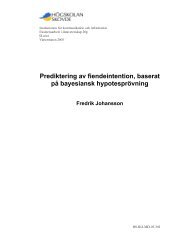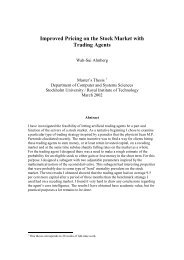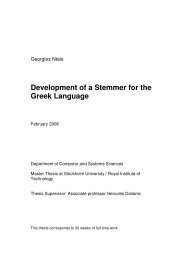Modeling Hydra Behavior Using Methods Founded in Behavior-Based Robotics
Modeling Hydra Behavior Using Methods Founded in ... - SAIS
Modeling Hydra Behavior Using Methods Founded in ... - SAIS
Create successful ePaper yourself
Turn your PDF publications into a flip-book with our unique Google optimized e-Paper software.
6.3. Constituent behaviors 25Release type, where a higher-priority behavior enables the output of a lower-prioritybehavior to pass through the switch.6.2.1 Applicability clauseThe AC def<strong>in</strong>es, for each behavior, whether the output from the behavioral unit shouldbe active or not. An AC can be situation-driven, i.e. related to a goal state, where thepresent state (result<strong>in</strong>g from the agent’s action) causes the AC to be either true or false. Asan example, consider a robot that turns only when an obstacle appears <strong>in</strong> front of the robot(and only until the object is no longer <strong>in</strong> front of it). The AC can also be event-driven. Anevent is characterized by a very brief (po<strong>in</strong>t-like) occurrence, whereas situations typicallyare extended <strong>in</strong>tervals of time [14]. An event-driven AC is of a set/reset type, where acerta<strong>in</strong> event triggers the AC, and some other criteria resets it.6.2.2 Transfer functionThe TF determ<strong>in</strong>es the actual action (output) of the behavioral module, given the currentmotivational state. The output from the TF is only passed out from the behavioral modulewhen the AC is true.6.3 Constituent behaviors<strong>Us<strong>in</strong>g</strong> the CSA, model<strong>in</strong>g each of the constituent behaviors consists of two steps, namely(1) def<strong>in</strong><strong>in</strong>g an AC, and (2) def<strong>in</strong><strong>in</strong>g a TF. The architectures of a behavioral module isillustrated <strong>in</strong> Fig. 6.3.As described <strong>in</strong> Section 4.1, there are several different methods by which behaviors canbe generated. In the case of <strong>Hydra</strong>, the constituent behaviors are relatively simple, andthus implementation by means of hand-cod<strong>in</strong>g was used <strong>in</strong> most cases. As a complementto hand-cod<strong>in</strong>g, biologically <strong>in</strong>spired methods such as RNNs and EAs were also used.A brief description of these methods is given <strong>in</strong> Appendices A and B, whereas specificimplementation details for the result<strong>in</strong>g behavioral model of the simulated <strong>Hydra</strong> arestated <strong>in</strong> Chapter 7.





